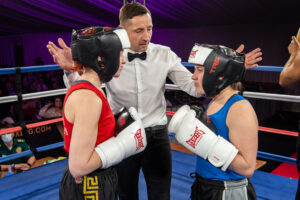Content-aware: comments around trauma, therapy and violence.
Have you ever been in a fight? I hadn’t.
Have you ever been punched in the face? I had not.
Do you know how you react when you’re cornered? I’m pretty good at talking my way out of difficult situations so I’ve never needed to find out.
This is a look at how I started off trying to re-motivate myself post-lockdown with a boxing challenge, and found the power of my inner child rather than the power of my punch.
It was the tail end of Lockdown and I was feeling very physically unhealthy. Having spent the majority of 2020 in the UCU world, reading psychology books about trauma, attachment theory and how the brain works, I was learning a lot about myself, my boundaries and my comfort levels. So when my cousin sent me a link to 10 weeks of women’s boxing training, I was curious enough to show up for the induction and as it turns out, looking for a new challenge.
I’ve always welcomed new experiences, whether that’s spending a week hiking up a mountain, waiting in the blistering wind to jump out of a plane or wandering through waist-deep snow to go boarding off-piste. I learn a lot about my ability to cope with mental and physical challenges by pushing myself into uncomfortable situations, getting to the point I think I can no longer cope and then having no option but to see it through. For me, there’s euphoria and peace in achieving something I thought was going to beat me. And I’m not the only one. According to Flow, The Classic Work on How to Achieve Happiness, by Mihaly Csikszentmihalyi (a magnificent book you’re likely to often see me reference), “the best moments usually occur when a person’s body or mind is stretched to its limits in a voluntary effort to accomplish something difficult and worthwhile. Optimal experience is thus something that we make happen.”
This specific challenge involved 10 weeks of training (2 nights per week and an optional Saturday morning), sparring with other women, then selling at least 20 tickets to a boxing event (proceeds going to a cancer charity of my choice), where me and the other participants would each have one fight lasting 6 minutes (3 rounds of 2 minutes). Spoiler: one of the longest 6 minutes of my life. I was taking part because HIIT (high intensity interval training, a method of training often used in boxing) is an excellent way of getting fit and I find it more interesting than cardio. Also, because I needed the accountability of coached sessions and a register being taken to make sure that I turned up. Mostly, I like learning new things, was curious about how fit I needed to be to last 6 minutes in the ring, and genuinely wanted to know if I could punch someone in the name of sport.
What I didn’t realise was that my subconscious had other reasons for me to taking part. It’s common for us humans to carry around cognitive biases and it wasn’t until much later that I realised I’d over-simplified my reasons for engaging in this challenge. What I discovered was that a part of me wanted to know I could protect myself.
First, I had to explain to my wife why I was willingly putting myself in this situation.
“There’s a fire in me,” I said, “that I can feel burning but that I can’t access.” I remembered that a much younger version of myself was a little powerhouse. She’s about 5-7 years old and she’s not scared of anything, but at the time I was feeling helpless, finding it hard to get out of bed in the morning, spending a lot of time in front of the TV and generally lacking motivation. I didn’t want to socialise or talk to people, I just wanted to hibernate. Having tried CBT and talking therapy for years I was getting frustrated with going over the same stuff. I knew something needed to shift, and taking on an enormous, unfathomable challenge has been my way of dusting off the cobwebs of lethargy. My wife was understandably concerned for my wellbeing but she understood. I later came across this poem in Midnight Library (by Matt Haig) which sums it up perfectly:
“She had a fire inside her. She wondered if the fire was to warm her or destroy her. Then she realised. A fire had no motive. Only she could have that. The power was hers.”
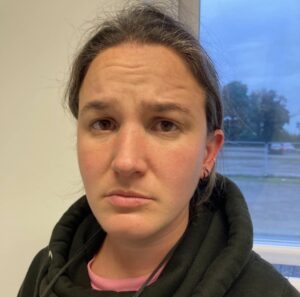 So I attended training and it was fine, like any other HIIT sessions but with boxing technique thrown in as well. Around week 3 however, I picked up covid and was out of action for another 3 weeks, to the point that the organiser told me if I was unable to return to training that third week then I’d be removed from the fight because I’d have missed too much and it wasn’t safe for me to take part. The reason I’d got involved was for a physical and personal battle so this threat of not getting to take part was the incentive I needed to get my gloves back on and find out what I’d missed.
So I attended training and it was fine, like any other HIIT sessions but with boxing technique thrown in as well. Around week 3 however, I picked up covid and was out of action for another 3 weeks, to the point that the organiser told me if I was unable to return to training that third week then I’d be removed from the fight because I’d have missed too much and it wasn’t safe for me to take part. The reason I’d got involved was for a physical and personal battle so this threat of not getting to take part was the incentive I needed to get my gloves back on and find out what I’d missed.
It turns out I’d missed loads. When I got back the women were throwing combinations of punches and using blocks and footwork – all learning that I’d missed. I’d also gone from being one of the fittest in the sessions to struggling to catch my breath because of the lingering respiratory issues. I was behind and trying to catch up not only with the technical aspects of boxing but also recover enough to be able to work anaerobically for over 5 minutes.
A few weeks later and I was starting to feel better and arranged with a very good friend to join her and her personal trainer at a session they do each week in the park. Her trainer is an MMA fighter and he taught me about combinations, movement and gave me my first experience of hitting pads at full force. It’s at that point I realised how much trouble I was in because it’s one thing to do circuits at training, it’s another thing to move around the ring and block punches. Having the stamina and presence of mind to throw combinations with force, whilst managing the adrenaline and avoiding getting hit, that’s something completely different and I did not have the time to get myself fit enough to cope with that. All I could do was hope that the trainers took into consideration that I was recovering from Covid and would match me against someone of equal fitness. Second spoiler: they did not.
 Unexpected outcomes
Unexpected outcomes
Not only was I taking myself on physically at the time, but having pulled myself out of The Pit I was ready to start looking at where else in my life I’d been holding back. I’d been introduce to Prue, who is the founder of Atlas of The Self – a process of deep exploration using guided meditation to explore the connection between Body and Mind. She knew that I was keen to reclaim the powerhouse who was that little girl I remember being, whom I felt like I’d lost access to since childhood and she took me on an internal journey of remembering, to do just that. In the same way therapies such as IFS (Internal Family Systems) use guided mediation to access parts of Self, so did Prue. She encouraged connection with this inner world and in particular my inner 5-7 year old, helping me get to know her, look at photos and videos of her and remember what it was like being her. Even though I’d walked the path of that little girl, it was incredibly difficult to remember her and even harder to embody her, a little girl who is effectively my most authentic self (before the rest of the world influenced who I should or could be).
What can happen when we experience an increibly unfavourable event (what people refer to as ‘trauma’) is that as a coping mechanism to help our survival, the brain shuts out or forgets parts of ourselves. In IFS, they call these parts Exiles and I’d effectively exiled the little girl within me. She had something horrible happen to her and as a way of continuing to cope in the world my brain had shut off from her, her memories and experiences.
One day, and I don’t remember how we got to this point, Prue encouraged me down a path that led to a very uncomfortable memory of that horrible thing that happened. A memory that some might call a trigger. One that sneaks up on you when you least expect it but is like a shiver down your spine, activating unpleasant emotions like anger, disgust, fear, or betrayal. Apparently, these memories jump out at us (like one time when I was just washing the dishes) as our survival mechanisms letting us know we’ve still got something to learn from the experience, as a way to keep us safe. That, I’m told, is what a trigger is – a safety mechanism in the mind to say, ‘hey, remember this rubbish thing that happened? Make sure you learn from it so that it doesn’t happen again.’ If we don’t feel like we’ve learnt the necessary lessons it keeps on at us, popping up every now and again to remind us. I’m not a psychologist, nor have I officially studied this stuff, I’m just speaking from my personal experience. That I had access to not many childhood memories and those I did have were sometimes of unpleasant interactions. One in particular that would shiver up my spine more often than I wanted.
That day working with Prue, we landed in the memory in questions and she asked me in that momeny, ‘what I’d like to have happen instead’. She was inviting me to rewrite the memory. Five-year-old me lashed out at the horrible person in the memory, punching and elbowing, feeling powerful and strong. Then Prue invited an older version of myself to come into the memory and asked if I’d like to go somewhere else. The teenage me came to take the little girl away from the situation and landed in my favourite local park.
This might not seem like much of a big deal for most people, but as someone whose stock response to danger is to freeze and dissociate I got to go from a passive response to an active one. To give you an example of how I had learned to freeze in response to danger, during that summer before the boxing I’d taken part in a self defence class. It was a one-day event hosted by a woman who had been assaulted. She’d channelled the negativity from that experience into creating a day for local woman to come together and receive training on how to confidently cope in confronting or unwanted situations. First we were asked to push the person away and shout, “No!” It took me 4 attempts to be even remotely believable. I felt shy, weak and silly. Then we learned how to get an attacker to the ground and run off. Learning this was like learning dance moves, so that helped. I grew up with lots of boys so it was like rough-and-tumble. Throughout the morning I became more and more aware that I couldn’t find my voice and wanted to shrink into the corner, and it really bothered me.
Through the work with Prue, my sympathetic nervous system was learning to come back online so that I could protect myself and feel more self-assured. It was giving me an alternative primal reaction – to ‘fight’ – and that felt grounding, like I was coming home to a version of myself I always knew existed, but that I couldn’t access because I was too busy trying to distract myself all the time so the horrible memory wouldn’t randomly pop in. Now, when I recall that unpleasant event, I’ve re-written it. Instead of being frozen and trapped in the moment, I lash out and protect myself. Instead of a shiver running down my spine, I smile to myself and feel strong. That single moment of imagined physical explosion gave me the ability to soak up more of the world, to care less about what other people thought of me and to genuinely relax into the very essence of my Being. Having learned more about the somatic system since then I realise that had it not been for the boxing training it’s unlikely I would have been able to imagine myself punching, elbowing and kicking in that way. It helped enormously that my nervous system knew what it felt like to lash out so that it could reimagine the actions within that uncomfortable memory and essentially heal the moment.
The fight
On the day of the fight I was unexpectedly relaxed. It turns out I’d already won the battle I’d signed up for, but I still had a mammoth task ahead. My opponent was a spectacular woman named Sarah, who was by far one of the fittest and most experienced boxers in my weight category. We’d only sparred together once and she was calm, engaged and seemed to know
what she was doing, so I was shocked when I got paired with her and knew I had a battle on my hands. It helped that she’s really funny, friendly and kind, and when we went out for dinner after the fight I found out she was there to take herself on in new ways as well. As Mr Csikszentmihalyi explains, great experiences don’t only happen when life is going great. Swathes of people from all around the world, with diverse life experiences report that “in the midst of their ordeal(s) they experienced extraordinarily rich epiphanies in response to such simple events.” We need crap stuff to happen to us so that we appreciate the good times, but that also it’s the crap times that arguably teach us the most about ourselves.
We arrived at the venue in the morning for medical examinations, and as the energy around me started to buzz I found myself floating. Part of the medical exam was testing our blood pressure to make sure we were safe to fight and one of the other participants was struggling to get her reading in range – her stress and anxiety levels were climbing – so I sat with her, going through breathing and visualisation techniques that I’d been able to do for myself since working with Prue. It worked at calming her body and she was allowed to fight.
A few weeks before I’d have laughed at you if you’d told me that prior to stepping in the ring I’d have been calm. There was no way I expected to face that kind of challenge the way I did, but I honestly didn’t care about the outcome, I was just there to have fun and see what happened. So let me tell you what happenend…
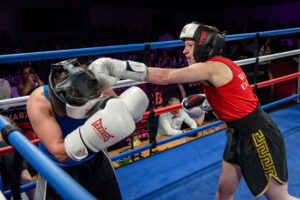 I got my butt handed to me.
I got my butt handed to me.
Looking back at the footage it doesn’t seem as one-sided as it felt in that ring, but throughout the fight, Sarah, the trainers and I knew it was clearly her night. From the moment we warmed up it was clear we were in different leagues. I was huffing and puffing from the combinations being thrown at me, and she was bouncing around like Tigger.
But what was evident to me was that we were there for different reasons. Even something as simple as the music we chose to play as we walked to the ring – hers was ‘So What’ by P!nk, a song about feeling powerful, strong and kicking your ex’s arse. I chose to skip up to the ring chuckling away to ‘So You Wanna Be A Boxer’ from Bugsy Malone, reminding me and everyone else that so far as violence is concerned, I’m a wannabe. I was also secretly hoping that a custard pie was greeting my face when I got to the ring rather than a boxing glove. But meet my face that glove did.
The bell rang and Sarah floated like a leaf on a lake and stung like a mosquito, while I got my gloves up in defence and took a pummelling by her jabs, hooks and upper-cuts (see, I did learn some stuff)! One thing I noticed about my capacity for fighting, however, was that I was only willing to take so much. She could not keep me on the ropes because I hated feeling cornered, and after a few seconds of 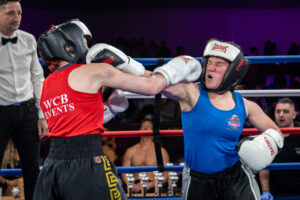 getting pounded a part of me would say, ‘that’s enough’ and I’d clock her on the noggin’ (“punched her in the head” if you don’t speak south-east-London-ish). Apparently, I could pack a punch (she told me through her bruised face the next day) and those jabs gave me just enough time to compose myself. In any other circumstance I think I’d have taken the opportunity to run away, but to the despair of my ring-side coach, I didn’t have the energy to capitalise on those small moments of having an advantage. My lungs were burning from the Covid hangover. Have you ever worked your body so hard that you start to taste blood in your throat? Yeah, that. It lasted ages after the fight as well. I maintain there is no sport more intense than the aerobic demands fighters put on their body. Massive respect to all of them.
getting pounded a part of me would say, ‘that’s enough’ and I’d clock her on the noggin’ (“punched her in the head” if you don’t speak south-east-London-ish). Apparently, I could pack a punch (she told me through her bruised face the next day) and those jabs gave me just enough time to compose myself. In any other circumstance I think I’d have taken the opportunity to run away, but to the despair of my ring-side coach, I didn’t have the energy to capitalise on those small moments of having an advantage. My lungs were burning from the Covid hangover. Have you ever worked your body so hard that you start to taste blood in your throat? Yeah, that. It lasted ages after the fight as well. I maintain there is no sport more intense than the aerobic demands fighters put on their body. Massive respect to all of them.
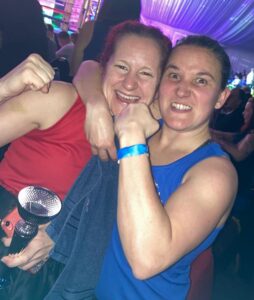 Am I glad I did it? Heck yes. I learnt a lot about myself. I healed parts that needed to know I could protect myself if need-be, I learned to listen to my instincts even when I couldn’t make rational sense of them, I figured out how to occupy my body and the present moment rather than constantly finding ways to distract myself or disassociating. Being in a fight definitely puts you in the here-and-now, whether you want to be or not.
Am I glad I did it? Heck yes. I learnt a lot about myself. I healed parts that needed to know I could protect myself if need-be, I learned to listen to my instincts even when I couldn’t make rational sense of them, I figured out how to occupy my body and the present moment rather than constantly finding ways to distract myself or disassociating. Being in a fight definitely puts you in the here-and-now, whether you want to be or not.
And I discovered that in an airplane hangar full of people shouting and screaming, above all the cacophony the voice I could hear the most hollering my name and words of encouragement, was my wife. When I asked her how she was able to watch me up there, she said, “because you wanted to do it and said that you needed to do it.” So she showed up with all the support and cheer and I couldn’t be more grateful to her, and to the other 19 amazing friends and family who bought tickets and still let me sit at their table after I’d lost . There’s also the amazing community of friends and family who couldn’t attend but raised money for charity. It would not have happened without them.
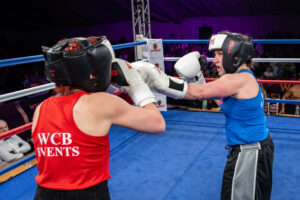 I’m aware that this particular challenge isn’t for everyone but we all have an awareness of our comfort zone and what we can do to explore the limits of it. It’s by choosing activities which stretch us that we learn and grow. None of the pain, discomfort or illness mattered because I knew why I was there… It was to bring some inspiration and novel experience into my life, to align myself with playfulness simply because I could, and not because I should. These are all aspects of myself that I know to be really important to me and they all led me to place of feeling amazing. Spiritually amazing , rather than physically – physically I was a bit of a mess for a few days, but bounced back reasonably quickly.
I’m aware that this particular challenge isn’t for everyone but we all have an awareness of our comfort zone and what we can do to explore the limits of it. It’s by choosing activities which stretch us that we learn and grow. None of the pain, discomfort or illness mattered because I knew why I was there… It was to bring some inspiration and novel experience into my life, to align myself with playfulness simply because I could, and not because I should. These are all aspects of myself that I know to be really important to me and they all led me to place of feeling amazing. Spiritually amazing , rather than physically – physically I was a bit of a mess for a few days, but bounced back reasonably quickly.
Something Prue said to me months back had stuck with me – that when you’re fighting something you’re tied to it forever. As long as you’re fighting it, you are giving it power. That is true of the unpleasant memory which now makes me smile rather than shiver. It has no power becuase I have no need to fight it anymore. It’s also true of Sarah. She will forever be tied as the person I got in a boxing fight with, and I must’ve been fighting pretty damn hard because she came back at me with a lot of power.
None of the journeys that each of us are on are linear, that much I know is true. We’re all trying to figure it out in our own sweet way. I wanted to share this story because when I was stuck in The Pit, it was hearing how other people had navigated the tough times which gave me hope that I could do it as well. There are people who lay their brave hearts on their sleeve when talking about overcoming traumas, and they do so with frank vulnerability so that we can see ourselves in their experience and belive that change is possible for us as well. I’m not sure that’s what this is. I made a decision to leave my past in my past, and aspects of it – namely the perpetrators – do not deserve airtime, energy or space in my story. Yet I do understand the desire to share, as proof of the hurdles we can overcome when we find suitable pathways over or around them. I’m not a therapist or gifted in guided meditation the way a practitioner like Prue is. However, it IS my responsibility as a facilitator to walk my talk and break down my own boundaries and limitations wherever I can. It’s on the foundation of work like U.C.U. that I was able to tackle these challenges, because I believe it starts with knowing who we are, what we’re great at, what’s most important to us, what we want from our lives and who we believe we can be in the world. If that’s something you’d like to chat about, absolutely get in touch.

